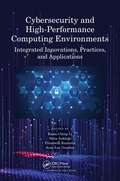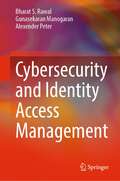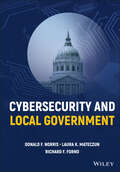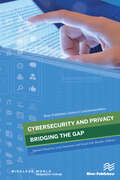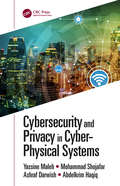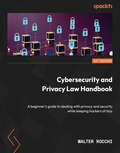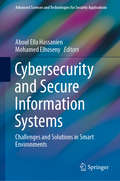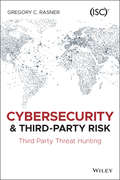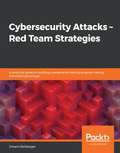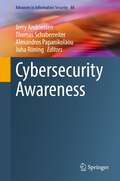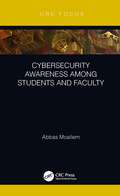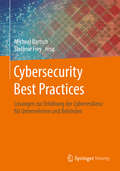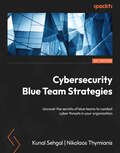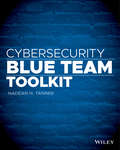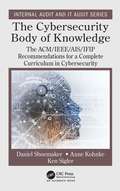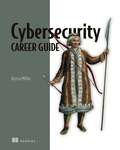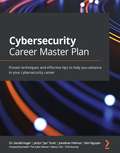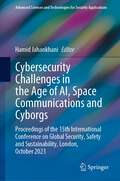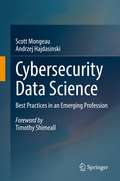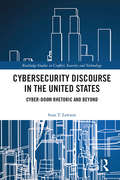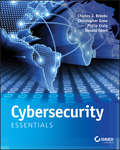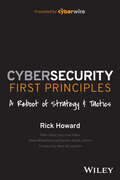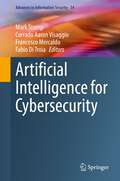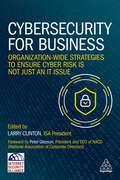- Table View
- List View
Cybersecurity and High-Performance Computing Environments: Integrated Innovations, Practices, and Applications
by Kuan-Ching LiIn this fast-paced global economy, academia and industry must innovate to evolve and succeed. Today’s researchers and industry experts are seeking transformative technologies to meet the challenges of tomorrow. Cutting-edge technological advances in cybersecurity solutions aid in enabling the security of complex heterogeneous high-performance computing (HPC) environments. On the other hand, HPC facilitates powerful and intelligent innovative models for reducing time to response to identify and resolve a multitude of potential, newly emerging cyberattacks. Cybersecurity and High-Performance Computing Environments provides a collection of the current and emergent research innovations, practices, and applications focusing on the interdependence of cybersecurity and HPC domains for discovering and resolving new emerging cyber-threats. KEY FEATURES Represents a substantial research contribution to the state-of-the-art solutions for addressing the threats to confidentiality, integrity, and availability (CIA triad) in HPC environments Covers the groundbreaking and emergent solutions that utilize the power of the HPC environments to study and understand the emergent, multifaceted, anomalous, and malicious characteristics The content will help university students, researchers, and professionals understand how HPC research fits broader cybersecurity objectives and vice versa.
Cybersecurity and Identity Access Management
by Bharat S. Rawal Gunasekaran Manogaran Alexender PeterThis textbook provides a comprehensive, thorough and up-to-date treatment of topics in cyber security, cyber-attacks, ethical hacking, and cyber crimes prevention. It discusses the different third-party attacks and hacking processes which a poses a big issue in terms of data damage or theft. The book then highlights the cyber security protection techniques and overall risk assessments to detect and resolve these issues at the beginning stage to minimize data loss or damage. This book is written in a way that it presents the topics in a simplified holistic and pedagogical manner with end-of chapter exercises and examples to cater to undergraduate students, engineers and scientists who will benefit from this approach.
Cybersecurity and Local Government
by Donald F. Norris Laura K. Mateczun Richard F. FornoCYBERSECURITY AND LOCAL GOVERNMENT Learn to secure your local government’s networks with this one-of-a-kind resource In Cybersecurity and Local Government, a distinguished team of researchers delivers an insightful exploration of cybersecurity at the level of local government. The book makes a compelling argument that every local government official, elected or otherwise, must be reasonably knowledgeable about cybersecurity concepts and provide appropriate support for it within their governments. It also lays out a straightforward roadmap to achieving those objectives, from an overview of cybersecurity definitions to descriptions of the most common security challenges faced by local governments. The accomplished authors specifically address the recent surge in ransomware attacks and how they might affect local governments, along with advice as to how to avoid and respond to these threats. They also discuss the cybersecurity law, cybersecurity policies that local government should adopt, the future of cybersecurity, challenges posed by Internet of Things, and much more. Throughout, the authors provide relevant field examples, case studies of actual local governments, and examples of policies to guide readers in their own application of the concepts discussed within. Cybersecurity and Local Government also offers: A thorough introduction to cybersecurity generally, including definitions of key cybersecurity terms and a high-level overview of the subject for non-technologists. A comprehensive exploration of critical information for local elected and top appointed officials, including the typical frequencies and types of cyberattacks. Practical discussions of the current state of local government cybersecurity, with a review of relevant literature from 2000 to 2021. In-depth examinations of operational cybersecurity policies, procedures and practices, with recommended best practices. Perfect for local elected and top appointed officials and staff as well as local citizens, Cybersecurity and Local Government will also earn a place in the libraries of those studying or working in local government with an interest in cybersecurity.
Cybersecurity and Privacy - Bridging the Gap (River Publishers Series In Communications Ser.)
by Samant Khajuria Lene Tolstrup Sørensen Knud Erik SkoubyThe huge potential in future connected services has as a precondition that privacy and security needs are dealt with in order for new services to be accepted. This issue is increasingly on the agenda both at company and at individual level. Cybersecurity and Privacy - bridging the gap addresses two very complex fields of the digital world, i.e., Cybersecurity and Privacy. These multifaceted, multidisciplinary and complex issues are usually understood and valued differently by different individuals, data holders and legal bodies. But a change in one field immediately affects the others. Policies, frameworks, strategies, laws, tools, techniques, and technologies - all of these are tightly interwoven when it comes to security and privacy. This book is another attempt to bridge the gap between the industry and academia. The book addresses the views from academia and industry on the subject.
Cybersecurity and Privacy in Cyber Physical Systems
by Yassine Maleh Shojafar Mohammad Darwish Ashraf Haqiq AbdelkrimCybersecurity and Privacy in Cyber-Physical Systems collects and reports on recent high-quality research that addresses different problems related to cybersecurity and privacy in cyber-physical systems (CPSs). It Presents high-quality contributions addressing related theoretical and practical aspects Improves the reader’s awareness of cybersecurity and privacy in CPSs Analyzes and presents the state of the art of CPSs, cybersecurity, and related technologies and methodologies Highlights and discusses recent developments and emerging trends in cybersecurity and privacy in CPSs Proposes new models, practical solutions, and technological advances related to cybersecurity and privacy in CPSs Discusses new cybersecurity and privacy models, prototypes, and protocols for CPSs This comprehensive book promotes high-quality research by bringing together researchers and experts in CPS security and privacy from around the world to share their knowledge of the different aspects of CPS security. Cybersecurity and Privacy in Cyber-Physical Systems is ideally suited for policymakers, industrial engineers, researchers, academics, and professionals seeking a thorough understanding of the principles of cybersecurity and privacy in CPSs. They will learn about promising solutions to these research problems and identify unresolved and challenging problems for their own research. Readers will also have an overview of CPS cybersecurity and privacy design.
Cybersecurity and Privacy Law Handbook: A beginner's guide to dealing with privacy and security while keeping hackers at bay
by Walter RocchiGet to grips with cybersecurity and privacy laws to protect your company's data and comply with international privacy standardsKey FeaturesComply with cybersecurity standards and protect your data from hackersFind the gaps in your company's security posture with gap analysis and business impact analysisUnderstand what you need to do with security and privacy without needing to pay consultantsBook DescriptionCybercriminals are incessantly coming up with new ways to compromise online systems and wreak havoc, creating an ever-growing need for cybersecurity practitioners in every organization across the globe who understand international security standards, such as the ISO27k family of standards. If you're looking to ensure that your company's data conforms to these standards, Cybersecurity and Privacy Law Handbook has got you covered. It'll not only equip you with the rudiments of cybersecurity but also guide you through privacy laws and explain how you can ensure compliance to protect yourself from cybercrime and avoid the hefty fines imposed for non-compliance with standards. Assuming that you're new to the field, this book starts by introducing cybersecurity frameworks and concepts used throughout the chapters. You'll understand why privacy is paramount and how to find the security gaps in your company's systems. There's a practical element to the book as well—you'll prepare policies and procedures to prevent your company from being breached. You'll complete your learning journey by exploring cloud security and the complex nature of privacy laws in the US. By the end of this cybersecurity book, you'll be well-placed to protect your company's data and comply with the relevant standards.What you will learnStrengthen the cybersecurity posture throughout your organizationUse both ISO27001 and NIST to make a better security frameworkUnderstand privacy laws such as GDPR, PCI CSS, HIPAA, and FTCDiscover how to implement training to raise cybersecurity awarenessFind out how to comply with cloud privacy regulationsExamine the complex privacy laws in the USWho this book is forIf you're a seasoned pro with IT security and / or cybersecurity, this book isn't for you. This book is aimed at novices, freshers, students, experts in other fields, and managers, that, are willing to learn, understand, and manage how a security function is working, especially if you need to be. Although the reader will be able, by reading this book, to build and manage a security function on their own, it is highly recommended to supervise a team devoted to implementing cybersecurity and privacy practices in an organization.
Cybersecurity and Secure Information Systems: Challenges and Solutions in Smart Environments (Advanced Sciences and Technologies for Security Applications)
by Aboul Ella Hassanien Mohamed ElhosenyThis book provides a concise overview of the current state of the art in cybersecurity and shares novel and exciting ideas and techniques, along with specific cases demonstrating their practical application. It gathers contributions by both academic and industrial researchers, covering all aspects of cybersecurity and addressing issues in secure information systems as well as other emerging areas. The content comprises high-quality research articles and reviews that promote a multidisciplinary approach and reflect the latest advances, challenges, requirements and methodologies. Thus, the book investigates e.g. security vulnerabilities, cybercrime, and privacy issues related to big data analysis, as well as advances in digital forensics, secure smart city services, and risk mitigation strategies for devices employing cyber-physical systems. Given its scope, the book offers a valuable resource for students, researchers, IT professionals and providers, citizens, consumers and policymakers involved or interested in the modern security procedures needed to protect our information and communication resources. Its goal is to foster a community committed to further research and education, and one that can also translate its findings into concrete practices.
Cybersecurity and Third-Party Risk: Third Party Threat Hunting
by Gregory C. RasnerSTRENGTHEN THE WEAKEST LINKS IN YOUR CYBERSECURITY CHAINAcross the world, the networks of hundreds of different world-class organizations have been breached in a seemingly never-ending stream of attacks that targeted the trusted vendors of major brands. From Target to Equifax, Home Depot, and GM, it seems as if no company is safe from a third-party incident or breach, regardless of size. And the advanced threats are now exploiting the intersection of weaknesses in cybersecurity and third-party risk management.In Cybersecurity and Third-Party Risk, veteran cybersecurity specialist Gregory Rasner walks readers through how to lock down the vulnerabilities posed to an organization’s network by third parties. You’ll discover how to move beyond a simple checklist and create an active, effective, and continuous system of third-party cybersecurity risk mitigation.The author discusses how to conduct due diligence on the third parties connected to your company’s networks and how to keep your information about them current and reliable. You’ll learn about the language you need to look for in a third-party data contract whether you’re offshoring or outsourcing data security arrangements.Perfect for professionals and executives responsible for securing their organizations’ systems against external threats, Cybersecurity and Third-Party Risk is an indispensable resource for all business leaders who seek to:Understand the fundamentals of third-party risk managementConduct robust intake and ongoing due diligencePerform on-site due diligence and close vendor risksSecure your software supply chainUtilize cloud and on-premises software securelyContinuously monitor your third-party vendors and prevent breaches
Cybersecurity Attacks – Red Team Strategies: A practical guide to building a penetration testing program having homefield advantage
by Johann RehbergerDevelop your red team skills by learning essential foundational tactics, techniques, and procedures, and boost the overall security posture of your organization by leveraging the homefield advantage Key Features Build, manage, and measure an offensive red team program Leverage the homefield advantage to stay ahead of your adversaries Understand core adversarial tactics and techniques, and protect pentesters and pentesting assets Book Description It's now more important than ever for organizations to be ready to detect and respond to security events and breaches. Preventive measures alone are not enough for dealing with adversaries. A well-rounded prevention, detection, and response program is required. This book will guide you through the stages of building a red team program, including strategies and homefield advantage opportunities to boost security. The book starts by guiding you through establishing, managing, and measuring a red team program, including effective ways for sharing results and findings to raise awareness. Gradually, you'll learn about progressive operations such as cryptocurrency mining, focused privacy testing, targeting telemetry, and even blue team tooling. Later, you'll discover knowledge graphs and how to build them, then become well-versed with basic to advanced techniques related to hunting for credentials, and learn to automate Microsoft Office and browsers to your advantage. Finally, you'll get to grips with protecting assets using decoys, auditing, and alerting with examples for major operating systems. By the end of this book, you'll have learned how to build, manage, and measure a red team program effectively and be well-versed with the fundamental operational techniques required to enhance your existing skills. What you will learn Understand the risks associated with security breaches Implement strategies for building an effective penetration testing team Map out the homefield using knowledge graphs Hunt credentials using indexing and other practical techniques Gain blue team tooling insights to enhance your red team skills Communicate results and influence decision makers with appropriate data Who this book is for This is one of the few detailed cybersecurity books for penetration testers, cybersecurity analysts, security leaders and strategists, as well as red team members and chief information security officers (CISOs) looking to secure their organizations from adversaries. The program management part of this book will also be useful for beginners in the cybersecurity domain. To get the most out of this book, some penetration testing experience, and software engineering and debugging skills are necessary.
Cybersecurity Awareness (Advances in Information Security #88)
by Jerry Andriessen Thomas Schaberreiter Alexandros Papanikolaou Juha RöningThis contributed volume tells the story of the establishment of a cybersecurity awareness framework for organizations, and how it was piloted in two public sector municipal contexts. It presents a clear picture of cybersecurity issues in municipalities and proposes a socio-technical solution for creating cybersecurity awareness, how to build the solution and what the impact is on the municipal contexts. The 9 chapters for this book also provide information regarding the design, the deployment and the evaluation of the technology.This book builds on the success of the European Horizon 2020 research and innovation project CS-AWARE. The research proposes the first cybersecurity situational awareness solution for local public administrations based on an analysis of the context, provides automatic incident detection and visualization, and enables information exchange with relevant national and EU level authorities involved in legislation and network security.Cybersecurity is one of the most challenging security problems for commercial companies, NGOs, governmental institutions as well as individuals. Reaching beyond the technology focused boundaries of classical information technology (IT) security, cybersecurity includes organizational and behavioral aspects of IT systems and that needs to comply to legal and regulatory framework for cybersecurity. While large corporations might have the resources to follow those developments and bring their IT infrastructure and services in line with the requirements, the burden for smaller organizations like local public administrations will be substantial and the required resources might not be available. New and innovative solutions that would help local public administration to ease the burden of being in line with cybersecurity requirements are needed.This book targets researchers working in cybersecurity, computer scientists, social scientists and advanced level students studying computer science and other related disciplines. Cybersecurity professionals as well as professionals working in local government contexts, including policy makers, communication experts and system administrators will also benefit from this book.
Cybersecurity Awareness Among Students and Faculty
by Abbas MoallemIn modern times, all individuals need to be knowledgeable about cybersecurity. They must have practical skills and abilities to protect themselves in cyberspace. What is the level of awareness among college students and faculty, who represent the most technologically active portion of the population in any society? According to the Federal Trade Commission’s 2016 Consumer Sentinel Network report, 19 percent of identity theft complaints came from people under the age of 29. About 74,400 young adults fell victim to identity theft in 2016. This book reports the results of several studies that investigate student and faculty awareness and attitudes toward cybersecurity and the resulting risks. It proposes a plan of action that can help 26,000 higher education institutions worldwide with over 207 million college students, create security policies and educational programs that improve security awareness and protection. Features Offers an understanding of the state of privacy awareness Includes the state of identity theft awareness Covers mobile phone protection Discusses ransomware protection Discloses a plan of action to improve security awareness
Cybersecurity Best Practices: Lösungen zur Erhöhung der Cyberresilienz für Unternehmen und Behörden
by Michael Bartsch Stefanie FreyDas Thema Cybersecurity ist so aktuell wie nie, denn im Cyberspace lassen sich nur schwer Grenzen in Bezug auf den Zugang zu Informationen, Daten und Redefreiheit setzen. Kriminelle nutzen die Lücken oft zu ihrem Vorteil aus. Die Vielzahl der IT-Systeme, ihre unterschiedlichen Nutzungsarten und ihre Innovations- und Lebenszyklen haben zu hohen Sicherheitsrisiken für Unternehmen und staatliche Einrichtungen geführt. Diese Risiken werden sich auch langfristig nicht so einfach aus der Welt schaffen lassen. Daher müssen Institutionen Strategien und Lösungen zu ihrem Selbstschutz entwickeln. Dieses Buch beschreibt Lösungsansätze und Best Practices aus den unterschiedlichsten Bereichen, die nachweislich zu einer höheren Resilienz gegenüber Cyberangriffen führen. Weltweit renommierte IT-Sicherheitsexperten berichten in 40 Beiträgen, wie sich staatliche Institutionen, unter anderem das Militär (Cyber Defence), Behörden, internationale Organisationen und Unternehmen besser gegen Cyberangriffe schützen und nachhaltige Schutzstrategien entwickeln können. Die Autoren widmen sich den Gründen und Zielen, die ihren jeweiligen Strategien zugrunde liegen, sie berichten, wie Unternehmen auf konkrete Cyberattacken reagiert haben und wie einzelne staatliche Institutionen angesichts nationaler Cyberstrategien agieren. In weiteren Kapiteln zeigen Wissenschaftler auf, was bei der Abwehr von Cyber-Attacken bereits heute möglich ist, welche Entwicklungen in Arbeit sind und wie diese in Zukunft eingesetzt werden können, um die Cyber-Sicherheit zu erhöhen. Im letzten Kapitel berichten Hersteller, Anwenderunternehmen und Dienstleister welche Best Practices sie in ihren Unternehmen eingeführt haben und wie andere Unternehmen ihrem Beispiel folgen können. Das Buch richtet sich an IT-Verantwortliche und -Sicherheitsbeauftragte in Unternehmen und anderen Organisationen, aber auch an Studierende in den verschiedenen IT-Studiengängen.
Cybersecurity Blue Team Strategies: Uncover the secrets of blue teams to combat cyber threats in your organization
by Kunal Sehgal Nikolaos ThymianisBuild a blue team for efficient cyber threat management in your organizationKey FeaturesExplore blue team operations and understand how to detect, prevent, and respond to threatsDive deep into the intricacies of risk assessment and threat managementLearn about governance, compliance, regulations, and other best practices for blue team implementationBook DescriptionWe've reached a point where all organizational data is connected through some network. With advancements and connectivity comes ever-evolving cyber threats - compromising sensitive data and access to vulnerable systems. Cybersecurity Blue Team Strategies is a comprehensive guide that will help you extend your cybersecurity knowledge and teach you to implement blue teams in your organization from scratch. Through the course of this book, you'll learn defensive cybersecurity measures while thinking from an attacker's perspective. With this book, you'll be able to test and assess the effectiveness of your organization's cybersecurity posture. No matter the medium your organization has chosen- cloud, on-premises, or hybrid, this book will provide an in-depth understanding of how cyber attackers can penetrate your systems and gain access to sensitive information. Beginning with a brief overview of the importance of a blue team, you'll learn important techniques and best practices a cybersecurity operator or a blue team practitioner should be aware of. By understanding tools, processes, and operations, you'll be equipped with evolving solutions and strategies to overcome cybersecurity challenges and successfully manage cyber threats to avoid adversaries. By the end of this book, you'll have enough exposure to blue team operations and be able to successfully set up a blue team in your organization.What you will learnUnderstand blue team operations and its role in safeguarding businessesExplore everyday blue team functions and tools used by themBecome acquainted with risk assessment and management from a blue team perspectiveDiscover the making of effective defense strategies and their operationsFind out what makes a good governance programBecome familiar with preventive and detective controls for minimizing riskWho this book is forThis book is for cybersecurity professionals involved in defending an organization's systems and assets against attacks. Penetration testers, cybersecurity analysts, security leaders, security strategists, and blue team members will find this book helpful. Chief Information Security Officers (CISOs) looking at securing their organizations from adversaries will also benefit from this book. To get the most out of this book, basic knowledge of IT security is recommended.
Cybersecurity Blue Team Toolkit
by Nadean H. TannerA practical handbook to cybersecurity for both tech and non-tech professionals As reports of major data breaches fill the headlines, it has become impossible for any business, large or small, to ignore the importance of cybersecurity. Most books on the subject, however, are either too specialized for the non-technical professional or too general for positions in the IT trenches. Thanks to author Nadean Tanner’s wide array of experience from teaching at a University to working for the Department of Defense, the Cybersecurity Blue Team Toolkit strikes the perfect balance of substantive and accessible, making it equally useful to those in IT or management positions across a variety of industries. This handy guide takes a simple and strategic look at best practices and tools available to both cybersecurity management and hands-on professionals, whether they be new to the field or looking to expand their expertise. Tanner gives comprehensive coverage to such crucial topics as security assessment and configuration, strategies for protection and defense, offensive measures, and remediation while aligning the concept with the right tool using the CIS Controls version 7 as a guide. Readers will learn why and how to use fundamental open source and free tools such as ping, tracert, PuTTY, pathping, sysinternals, NMAP, OpenVAS, Nexpose Community, OSSEC, Hamachi, InSSIDer, Nexpose Community, Wireshark, Solarwinds Kiwi Syslog Server, Metasploit, Burp, Clonezilla and many more. Up-to-date and practical cybersecurity instruction, applicable to both management and technical positions • Straightforward explanations of the theory behind cybersecurity best practices • Designed to be an easily navigated tool for daily use • Includes training appendix on Linux, how to build a virtual lab and glossary of key terms The Cybersecurity Blue Team Toolkit is an excellent resource for anyone working in digital policy as well as IT security professionals, technical analysts, program managers, and Chief Information and Technology Officers. This is one handbook that won’t gather dust on the shelf, but remain a valuable reference at any career level, from student to executive.
The Cybersecurity Body of Knowledge: The ACM/IEEE/AIS/IFIP Recommendations for a Complete Curriculum in Cybersecurity (Internal Audit and IT Audit)
by Daniel Shoemaker Anne Kohnke Ken SiglerThe Cybersecurity Body of Knowledge explains the content, purpose, and use of eight knowledge areas that define the boundaries of the discipline of cybersecurity. The discussion focuses on, and is driven by, the essential concepts of each knowledge area that collectively capture the cybersecurity body of knowledge to provide a complete picture of the field. This book is based on a brand-new and up to this point unique, global initiative, known as CSEC2017, which was created and endorsed by ACM, IEEE-CS, AIS SIGSEC, and IFIP WG 11.8. This has practical relevance to every educator in the discipline of cybersecurity. Because the specifics of this body of knowledge cannot be imparted in a single text, the authors provide the necessary comprehensive overview. In essence, this is the entry-level survey of the comprehensive field of cybersecurity. It will serve as the roadmap for individuals to later drill down into a specific area of interest. This presentation is also explicitly designed to aid faculty members, administrators, CISOs, policy makers, and stakeholders involved with cybersecurity workforce development initiatives. The book is oriented toward practical application of a computing-based foundation, crosscutting concepts, and essential knowledge and skills of the cybersecurity discipline to meet workforce demands. Dan Shoemaker, PhD, is full professor, senior research scientist, and program director at the University of Detroit Mercy’s Center for Cyber Security and Intelligence Studies. Dan is a former chair of the Cybersecurity & Information Systems Department and has authored numerous books and journal articles focused on cybersecurity. Anne Kohnke, PhD, is an associate professor of cybersecurity and the principle investigator of the Center for Academic Excellence in Cyber Defence at the University of Detroit Mercy. Anne’s research is focused in cybersecurity, risk management, threat modeling, and mitigating attack vectors. Ken Sigler, MS, is a faculty member of the Computer Information Systems (CIS) program at the Auburn Hills campus of Oakland Community College in Michigan. Ken’s research is in the areas of software management, software assurance, and cybersecurity.
Cybersecurity Career Guide
by Alyssa MillerKickstart a career in cybersecurity by adapting your existing technical and non-technical skills. Author Alyssa Miller has spent fifteen years in cybersecurity leadership and talent development, and shares her unique perspective in this revealing industry guide.In Cybersecurity Career Guide you will learn: Self-analysis exercises to find your unique capabilities and help you excel in cybersecurity How to adapt your existing skills to fit a cybersecurity role Succeed at job searches, applications, and interviews to receive valuable offers Ways to leverage professional networking and mentoring for success and career growth Building a personal brand and strategy to stand out from other applicants Overcoming imposter syndrome and other personal roadblocks Cybersecurity Career Guide unlocks your pathway to becoming a great security practitioner. You&’ll learn how to reliably enter the security field and quickly grow into your new career, following clear, practical advice that&’s based on research and interviews with hundreds of hiring managers. Practical self-analysis exercises identify gaps in your resume, what makes you valuable to an employer, and what you want out of your career in cyber. You&’ll assess the benefits of all major professional qualifications, and get practical advice on relationship building with mentors. About the technology Do you want a rewarding job in cybersecurity? Start here! This book highlights the full range of exciting security careers and shows you exactly how to find the role that&’s perfect for you. You&’ll go through all the steps—from building the right skills to acing the interview. Author and infosec expert Alyssa Miller shares insights from fifteen years in cybersecurity that will help you begin your new career with confidence. About the book Cybersecurity Career Guide shows you how to turn your existing technical skills into an awesome career in information security. In this practical guide, you&’ll explore popular cybersecurity jobs, from penetration testing to running a Security Operations Center. Actionable advice, self-analysis exercises, and concrete techniques for building skills in your chosen career path ensure you&’re always taking concrete steps towards getting hired. What's inside Succeed at job searches, applications, and interviews Building your professional networking and finding mentors Developing your personal brand Overcoming imposter syndrome and other roadblocks About the reader For readers with general technical skills who want a job in cybersecurity. About the author Alyssa Miller has fifteen years of experience in the cybersecurity industry, including penetration testing, executive leadership, and talent development. Table of Contents PART 1 EXPLORING CYBERSECURITY CAREERS 1 This thing we call cybersecurity 2 The cybersecurity career landscape 3 Help wanted, skills in a hot market PART 2 PREPARING FOR AND MASTERING YOUR JOB SEARCH 4 Taking the less traveled path 5 Addressing your capabilities gap 6 Resumes, applications, and interviews PART 3 BUILDING FOR LONG-TERM SUCCESS 7 The power of networking and mentorship 8 The threat of impostor syndrome 9 Achieving success
Cybersecurity Career Master Plan: Proven techniques and effective tips to help you advance in your cybersecurity career
by Dr. Gerald Auger Jaclyn “Jax” Scott Jonathan Helmus Kim Nguyen Heath "The AdamsGet started with cybersecurity and progress with the help of expert tips to get certified, find a job, and moreKey FeaturesLearn how to follow your desired career path that results in a well-paid, rewarding job in cybersecurityExplore expert tips relating to career paths and certification optionsAccess informative content from a panel of experienced cybersecurity expertsBook DescriptionCybersecurity is an emerging career trend and will continue to become increasingly important. Despite the lucrative pay and significant career growth opportunities, many people are unsure of how to get started.This book is designed by leading industry experts to help you enter the world of cybersecurity with confidence, covering everything from gaining the right certification to tips and tools for finding your first job. The book starts by helping you gain a foundational understanding of cybersecurity, covering cyber law, cyber policy, and frameworks. Next, you'll focus on how to choose the career field best suited to you from options such as security operations, penetration testing, and risk analysis. The book also guides you through the different certification options as well as the pros and cons of a formal college education versus formal certificate courses. Later, you'll discover the importance of defining and understanding your brand. Finally, you'll get up to speed with different career paths and learning opportunities.By the end of this cyber book, you will have gained the knowledge you need to clearly define your career path and develop goals relating to career progression.What you will learnGain an understanding of cybersecurity essentials, including the different frameworks and laws, and specialtiesFind out how to land your first job in the cybersecurity industryUnderstand the difference between college education and certificate coursesBuild goals and timelines to encourage a work/life balance while delivering value in your jobUnderstand the different types of cybersecurity jobs available and what it means to be entry-levelBuild affordable, practical labs to develop your technical skillsDiscover how to set goals and maintain momentum after landing your first cybersecurity jobWho this book is forThis book is for college graduates, military veterans transitioning from active service, individuals looking to make a mid-career switch, and aspiring IT professionals. Anyone who considers cybersecurity as a potential career field but feels intimidated, overwhelmed, or unsure of where to get started will also find this book useful.
Cybersecurity Challenges in the Age of AI, Space Communications and Cyborgs: Proceedings of the 15th International Conference on Global Security, Safety and Sustainability, London, October 2023 (Advanced Sciences and Technologies for Security Applications)
by Hamid JahankhaniThis book provides an opportunity for researchers, scientists, government officials, strategist and operators and maintainers of large, complex and advanced systems and infrastructure to update their knowledge with the state of best practice in the challenging domains while networking with the leading representatives, researchers and solution providers. The advancement of Artificial Intelligence (AI), coupled with the prolificacy of the Internet of Things (IoT) devices are creating smart societies that are interconnected. Space exploration and satellite, drone and UAV technology have travelled a long way in recent years and some may debate that we are in the midst of a revolution; in terms of development and the increasing number of these devices being launched. But with this revolutionary progress, it presents itself with new challenges in terms of governance. The ethical implications of connecting the physical and digital worlds, and presenting the reality of a truly interconnected society, presents the realization of the concept of smart societies in reality.Drawing on 14 years of successful events on Information security, digital forensics and cybercrime, the 15th ICGS3-23 conference aims to provide attendees with an information-packed agenda with representatives from across the industry and the globe. The challenges of complexity, rapid pace of change and risk/opportunity issues associated with modern products, systems, special events and infrastructures. In an era of unprecedented volatile, political and economic environment across the world, computer based systems face ever more increasing challenges, disputes and responsibilities and while the Internet has created a global platform for the exchange of ideas, goods and services, however, it has also created boundless opportunities for cyber-crime.This book presents new materials and contributes to knowledge through the technological advances that are being made across artificial intelligence (AI), machine learning, blockchain and quantum computing. These technologies driven by a digital revolution are expected to be disruptive and provide major digital transformation in the way societies operate today. As a result, these advances provide social and economic benefits, but, also, provide new challenges that security industry need to raise their game to combat them.
Cybersecurity Data Science: Best Practices in an Emerging Profession
by Scott Mongeau Andrzej HajdasinskiThis book encompasses a systematic exploration of Cybersecurity Data Science (CSDS) as an emerging profession, focusing on current versus idealized practice. This book also analyzes challenges facing the emerging CSDS profession, diagnoses key gaps, and prescribes treatments to facilitate advancement. Grounded in the management of information systems (MIS) discipline, insights derive from literature analysis and interviews with 50 global CSDS practitioners. CSDS as a diagnostic process grounded in the scientific method is emphasized throughout Cybersecurity Data Science (CSDS) is a rapidly evolving discipline which applies data science methods to cybersecurity challenges. CSDS reflects the rising interest in applying data-focused statistical, analytical, and machine learning-driven methods to address growing security gaps. This book offers a systematic assessment of the developing domain. Advocacy is provided to strengthen professional rigor and best practices in the emerging CSDS profession. This book will be of interest to a range of professionals associated with cybersecurity and data science, spanning practitioner, commercial, public sector, and academic domains. Best practices framed will be of interest to CSDS practitioners, security professionals, risk management stewards, and institutional stakeholders. Organizational and industry perspectives will be of interest to cybersecurity analysts, managers, planners, strategists, and regulators. Research professionals and academics are presented with a systematic analysis of the CSDS field, including an overview of the state of the art, a structured evaluation of key challenges, recommended best practices, and an extensive bibliography.
Cybersecurity Discourse in the United States: Cyber-Doom Rhetoric and Beyond (Routledge Studies in Conflict, Security and Technology)
by Sean T. LawsonThis book examines the role of cyber-doom rhetoric in the U.S. cybersecurity debate.For more than two decades, fear of "cyber-doom" scenarios—i.e. cyberattacks against critical infrastructure resulting in catastrophic physical, social, and economic impacts—has been a persistent feature of the U.S. cybersecurity debate. This is despite the fact that no cyberattack has come close to realizing such impacts. This book argues that such scenarios are part of a broader rhetoric of cyber-doom within the U.S. cybersecurity debate, and takes a multidisciplinary approach that draws on research in history, sociology, communication, psychology, and political science. It identifies a number of variations of cyber-doom rhetoric, then places them into a larger historical context, assesses how realistic the fears expressed in such rhetoric are, and finally draws out the policy implications of relying on these fears to structure our response to cybersecurity challenges. The United States faces very real cybersecurity challenges that are, nonetheless, much less dramatic than what is implied in the rhetoric. This book argues that relying on cyber-doom rhetoric to frame our thinking about such threats is counterproductive, and encourages us to develop ways of thinking and speaking about cybersecurity beyond cyber-doom.This book will be of much interest to students of cybersecurity, foreign policy, public administration, national security, and international relations in general.
Cybersecurity Essentials
by Charles J. Brooks Christopher Grow Philip Craig Donald ShortAn accessible introduction to cybersecurity concepts and practices Cybersecurity Essentials provides a comprehensive introduction to the field, with expert coverage of essential topics required for entry-level cybersecurity certifications. An effective defense consists of four distinct challenges: securing the infrastructure, securing devices, securing local networks, and securing the perimeter. Overcoming these challenges requires a detailed understanding of the concepts and practices within each realm. This book covers each challenge individually for greater depth of information, with real-world scenarios that show what vulnerabilities look like in everyday computing scenarios. Each part concludes with a summary of key concepts, review questions, and hands-on exercises, allowing you to test your understanding while exercising your new critical skills. Cybersecurity jobs range from basic configuration to advanced systems analysis and defense assessment. This book provides the foundational information you need to understand the basics of the field, identify your place within it, and start down the security certification path. Learn security and surveillance fundamentals Secure and protect remote access and devices Understand network topologies, protocols, and strategies Identify threats and mount an effective defense Cybersecurity Essentials gives you the building blocks for an entry level security certification and provides a foundation of cybersecurity knowledge
Cybersecurity First Principles: A Reboot of Strategy and Tactics
by Rick HowardThe first expert discussion of the foundations of cybersecurity In Cybersecurity First Principles, Rick Howard, the Chief Security Officer, Chief Analyst, and Senior fellow at The Cyberwire, challenges the conventional wisdom of current cybersecurity best practices, strategy, and tactics and makes the case that the profession needs to get back to first principles. The author convincingly lays out the arguments for the absolute cybersecurity first principle and then discusses the strategies and tactics required to achieve it. In the book, you'll explore: Infosec history from the 1960s until the early 2020s and why it has largely failed What the infosec community should be trying to achieve instead The arguments for the absolute and atomic cybersecurity first principle The strategies and tactics to adopt that will have the greatest impact in pursuing the ultimate first principle Case studies through a first principle lens of the 2015 OPM hack, the 2016 DNC Hack, the 2019 Colonial Pipeline hack, and the Netflix Chaos Monkey resilience program A top to bottom explanation of how to calculate cyber risk for two different kinds of companies This book is perfect for cybersecurity professionals at all levels: business executives and senior security professionals, mid-level practitioner veterans, newbies coming out of school as well as career-changers seeking better career opportunities, teachers, and students.
Cybersecurity for Artificial Intelligence (Advances in Information Security #54)
by Mark Stamp Fabio Di Troia Corrado Aaron Visaggio Francesco MercaldoThis book explores new and novel applications of machine learning, deep learning, and artificial intelligence that are related to major challenges in the field of cybersecurity. The provided research goes beyond simply applying AI techniques to datasets and instead delves into deeper issues that arise at the interface between deep learning and cybersecurity.This book also provides insight into the difficult "how" and "why" questions that arise in AI within the security domain. For example, this book includes chapters covering "explainable AI", "adversarial learning", "resilient AI", and a wide variety of related topics. It’s not limited to any specific cybersecurity subtopics and the chapters touch upon a wide range of cybersecurity domains, ranging from malware to biometrics and more.Researchers and advanced level students working and studying in the fields of cybersecurity (equivalently, information security) or artificial intelligence (including deep learning, machine learning, big data, and related fields) will want to purchase this book as a reference. Practitioners working within these fields will also be interested in purchasing this book.
Cybersecurity for Beginners
by Raef MeeuwisseThis book provides an easy insight into the essentials of cybersecurity, even if you have a non-technical background. You may be a business person keen to understand this important subject area or an information security specialist looking to update your knowledge. <p><p>The world has changed more in the past 10 years than in any 10 year period in human history... Technology is no longer a peripheral servant, it shapes our daily lives. Companies that can use technology wisely and well are booming, companies that make bad or no technology choices collapse and disappear. <p><p>The cloud, smart devices and the ability to connect almost any object to the internet are an essential landscape to use but are also fraught with new risks and dangers of a magnitude never seen before. <p><p>Also featuring an alphabetical section at the back of the book to help you translate many of the main cybersecurity technical terms into plain, non-technical English. This is the second edition of this book with updates and additional content. If you are looking for a book on personal cybersecurity steps, try my other publication "How to Keep Your Stuff Safe Online"
Cybersecurity for Business: Organization-Wide Strategies to Ensure Cyber Risk Is Not Just an IT Issue
by Larry ClintonBalance the benefits of digital transformation with the associated risks with this guide to effectively managing cybersecurity as a strategic business issue. Important and cost-effective innovations can substantially increase cyber risk and the loss of intellectual property, corporate reputation and consumer confidence. Over the past several years, organizations around the world have increasingly come to appreciate the need to address cybersecurity issues from a business perspective, not just from a technical or risk angle. Cybersecurity for Business builds on a set of principles developed with international leaders from technology, government and the boardroom to lay out a clear roadmap of how to meet goals without creating undue cyber risk.This essential guide outlines the true nature of modern cyber risk, and how it can be assessed and managed using modern analytical tools to put cybersecurity in business terms. It then describes the roles and responsibilities each part of the organization has in implementing an effective enterprise-wide cyber risk management program, covering critical issues such as incident response, supply chain management and creating a culture of security. Bringing together a range of experts and senior leaders, this edited collection enables leaders and students to understand how to manage digital transformation and cybersecurity from a business perspective.
